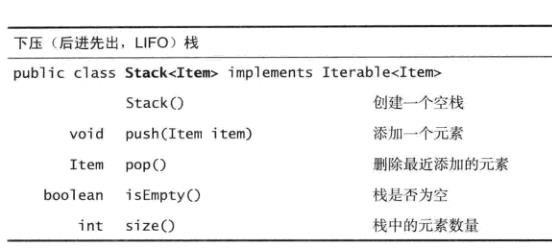算法实现栈和队列
Posted 外婆的
tags:
篇首语:本文由小常识网(cha138.com)小编为大家整理,主要介绍了算法实现栈和队列相关的知识,希望对你有一定的参考价值。
栈(stack)
栈(stack)是一种后进先出(LIFO)的集合类型, 即后来添加的数据会先被删除

可以将其类比于下面文件的取放操作:新到的文件会被先取走,这使得每次取走的文件都是最新的。

栈可以用数组或者队列去实现
下面要实现的栈的API如下图所示:

用数组实现栈
下面我们通过数组实现一个指定了初始容量,但随着元素的增加能够动态地扩张容量的栈。注意: 因为数组指定大小后不可改变, 所以我们要定义自动扩大栈容量的操作
public class ArrayStack<Item> { // 栈元素的总数 private int N = 0; // 存放栈元素的数组 private Item [] items; public ArrayStack (int M) { items = (Item[]) new Object[M]; } /** * @description: 调整栈的大小 */ private void resize (int max) { Item [] temp = (Item [])new Object[max]; for (int i =0;i<items.length;i++) { temp[i] = items[i]; } items = temp; } /** * @description: 向栈顶插入元素 */ public void push (Item item) { // 当栈满了的时候, 将栈的数组大小扩大为原来两倍 if (N==items.length) resize(2*N); items[N++] = item; } /** * @description: 从栈顶删除元素,并将删除的元素返回 */ public Item pop () { // 当栈还是空的时候, 不删除并且返回空 if(isEmpty()) return null; // 保存将要被删除的元素 Item i = items[N-1]; // 将该元素删除 items[N-1] = null; // 栈的长度减1 N--; return i; } /** * @description: 判断栈是否为空 */ public boolean isEmpty () { return N == 0; } /** * @description: 返回栈的大小 */ public int size () { return N; } public static void main (String args []) { // 开始时指定栈的容量为2 ArrayStack<Integer> stack = new ArrayStack<>(2); // 向栈顶依次添加3个元素 stack.push(1); stack.push(2); stack.push(3); // 添加3后栈的容量自动扩大了 // 依次从栈顶删除3个元素 System.out.println(stack.pop()); System.out.println(stack.pop()); System.out.println(stack.pop()); } }
输出:
3 2 1
用链表实现栈
下面展示用链表实现的栈的代码, 注意: 添加和删除操作都是在链表的头部进行的
public class LinkedListStack<Item> { // 栈中元素的总数 private int N = 0; // 链表头元素 private Node front; // 内部结点类 private class Node { Item item; Node next; } /** * @description: 向栈顶插入元素 */ public void push (Item item) { Node oldFront = front; // 向链表头部插入新的结点 front = new Node(); front.item = item; // 将新头结点的next指针指向旧的头结点 front.next = oldFront; // 栈的长度加1 N++; } /** * @description: 向栈顶删除元素,并将删除的元素返回 */ public Item pop () { // 当栈还是空的时候, 不删除并且返回空 if(isEmpty()) return null; // 保存待删除的项以便返回 Item item = front.item; // 删除原头结点 front = front.next; // 栈的长度减1 N--; return item; } /** * @description: 判断栈是否为空 */ public boolean isEmpty () { return N == 0; } /** * @description: 返回栈的大小 */ public int size () { return N; } public static void main (String args []) { // 创建栈 LinkedListStack<Integer> stack = new LinkedListStack<>(); // 向栈顶依次添加3个元素 stack.push(1); stack.push(2); stack.push(3); // 依次从栈顶删除3个元素 System.out.println(stack.pop()); System.out.println(stack.pop()); System.out.println(stack.pop()); } }
输出:
3 2 1
队列(queue)
队列属于一种遵循先进先出(FIFO)原则的集合类型,可以将其类比为生活中一些以公平性为原则的服务场景: 排成一排的客户等待服务,等待最久即最先入列的客户应该最先提供服务(出列)

实现队列也有两种方式,一种是链表, 另一种是循环数组
队列和栈在实现上的不同
- 栈遵循后进先出的原则,所以要在数组或链表同一端做添加和删除操作
- 队列遵循先进先出的原则, 所以要在数组或链表的两端分别做插入和删除的操作
我们要实现的队列API如下图所示:

通过链表实现队列
public class LinkedListQueue<Item> { // 链表中的结点数目 private int N = 0; // 链表头结点 private Node front = null; // 链表尾结点 private Node rear = null; // 结点内部类 private class Node { Item item; Node next; } /** * @description: 元素入列(在链表尾部添加) */ public void enqueue (Item item) { Node oldRear = rear; rear = new Node(); rear.item = item; if (isEmpty()) front = rear; else oldRear.next = rear; N++; } /** * @description: 元素出列(在链表头部删除) */ public Item dequeue () { if(isEmpty()) return null; Item item = front.item; front = front.next; N--; if(isEmpty()) rear = null; return item; } /** * @description: 判断队列是否为空 */ public boolean isEmpty () { return N == 0; } /** * @description: 返回队列长度 */ public int size () { return N; } public static void main (String args []) { LinkedListQueue<String> queue = new LinkedListQueue<>(); queue.enqueue("A"); queue.enqueue("B"); queue.enqueue("C"); queue.enqueue("D"); System.out.println(queue.dequeue()); System.out.println(queue.dequeue()); System.out.println(queue.dequeue()); System.out.println(queue.dequeue()); } }
输出:
A
B
C
D
头部删除-尾部添加 OR 头部添加-尾部删除?
在上面的代码中,我们是通过在链表尾部添加结点,在链表头部删除结点的操作实现队列, 那能不能通过在链表头部添加结点,在链表尾部删除结点的方式实现队列呢? 这是可以的,但并不是一个合适的做法,因为如果这样操作,在单向链表的条件下,需要将链表从头到尾迭代一遍才能实现删除操作,而我们通过上面的“头部删除-尾部添加”就能避免这种开销。
通过在链表头部添加结点,在链表尾部删除结点实现队列(不推荐)
/** * @description: 元素入列(在链表头部添加) */ public void enqueue (Item item) { Node oldFront = front; front = new Node(); front.item = item; front.next = oldFront; if (isEmpty()) rear = front; N++; } /** * @description: 元素出列(在链表尾部删除) */ public Item dequeue () { if (isEmpty()) return null; if (size()==1) { Item item = rear.item; front = null; rear = null; N--; return item; } Node x = front; while (!x.next.equals(rear)) { x=x.next; } Item item = x.next.item; x.next = null; rear = x; N--; return item; }
通过循环数组实现队列
除了链表之外, 另外一种实现队列的方式是循环数组。
为什么需要循环数组?
因为仅靠普通的数组实现队列可能会导致一个问题: 数组大量空位元素得不到利用。
例如下图所示, 在数组的实现方式中,我们会使用front和rear两个指针跟踪队列头部元素和尾部元素的位置,在动态的出列和入列操作中它们的位置会不断发生变化,随着出列操作fron指针t会不断后移(a->b->c->d), 当front和rear到达图d的状态时,我们发现:front前面的元素有一大段因为出列而腾出的空的元素没有得到利用,而此时又无法继续入列了(rear指针到达数组尾部,再次入列将导致数组越界的错误)

现在我们有一个方式可以解决这个问题: 将数组的头部和尾部连在一起,构成一个循环数组:

代码如下图所示, 可以看到,实现循环的关键是使用的一个取余数的操作,使得指针在移动到数组尾部的时候,能够重新移动到数组的头部:
public class CircleArrayQueue<Item> { // 队列元素总数 private int N = 0; // 数组长度 private int M; // 队列头部元素指针 private int front = 0; // 队列尾部元素指针 private int rear = 0; private Item [] items; public CircleArrayQueue (int M) { this.M = M; items = (Item [])new Object[M]; } /** * @description: 入列操作 */ public void enqueue (Item item) { // 当队列为空时, 不能进行入列操作 if (isFull()) return; // 向队列尾部插入元素 items[rear] = item; // 用数组长度M取余, 使得rear到达数组尾部时能返回数组头部 rear = (rear + 1) % M; // 增加队列长度 N++; } /** * @description: 出列,并返回被删除项 */ public Item dequeue () { // 当队列为满时, 不能进行出列操作 if (isEmpty()) return null; // 保存待删除元素, 以待返回 Item item = items[front]; // 删除队列头部元素 items[front] = null; // 用数组长度M取余, 使得front到达数组尾部时能返回数组头部 front = (front + 1) % M; // 减少队列长度 N--; // 返回删除元素 return item; } /** * @description: 判断队列是否满了 */ public boolean isFull () { return N == M; } /** * @description: 判断队列是否为空 */ public boolean isEmpty () { return N == 0; } /** * @description: 返回队列元素总数 */ public int size () { return N; } public static void main (String args []) { CircleArrayQueue<Integer> queue = new CircleArrayQueue<>(3); // 依次入列三个元素 queue.enqueue(1); queue.enqueue(2); queue.enqueue(3); // 依次出列三个元素 System.out.println(queue.dequeue()); System.out.println(queue.dequeue()); System.out.println(queue.dequeue()); } }
输出:
1 2 3
判断循环数组的满状态和空状态
在循环数组的实现中,一个非常重要的操作就是区分数组是处在"满"状态还是“空”状态,因为当front和rear指向同一个元素位置时,既可能处在满状态也可能处在空状态。上面的代码里我们是通过一个表示队列元素总数的变量N去判断的,除此之外,我们也可以通过另外一种不依赖于变量N的方式去判断数组的满和空的状态, 但代价是少用一个元素空间,例如:
(下面的代码除了isEmpty和isFull外都和上面相同)
public class CircleArrayQueue2<Item> { private int M; private int front = 0; private int rear = 0; private Item [] items; public CircleArrayQueue2 (int M) { this.M = M; items = (Item [])new Object[M]; } public void enqueue (Item item) { if (isFull()) return; items[rear] = item; rear = (rear + 1) % M; } public Item dequeue () { if (isEmpty()) return null; Item item = items[front]; items[front] = null; front = (front + 1) % M; return item; } public boolean isFull () { return (rear + 1) % M == front; } public boolean isEmpty () { return rear == front; } public static void main (String args []) { CircleArrayQueue2<Integer> queue = new CircleArrayQueue2<>(3); queue.enqueue(1); queue.enqueue(2); queue.enqueue(3); System.out.println(queue.dequeue()); System.out.println(queue.dequeue()); System.out.println(queue.dequeue()); } }
输出:
1
2
null
由输出可看出, 在数组长度为3时, 我们实际上只能有2个元素位置去存储队列元素
【完】
以上是关于算法实现栈和队列的主要内容,如果未能解决你的问题,请参考以下文章